Predicting the Current and Future Habitat Distribution for an Important Fruit Pest, Grapholita dimorpha Komai (Lepidoptera: Tortricidae), Using an Optimized MaxEnt Model
Simple Summary
Abstract
1. Introduction
2. Materials and Methods
2.1. Occurrence Records
2.2. Bioclimatic Variables
2.3. Model Selection and Setting
2.4. Model Evaluation and Analyses
3. Results
3.1. Variable Selection, Model Parameters, and Model Performance
3.2. Variables’ Importance in the Modeling
3.3. Response Curves of the Top Four Contributing Variables Concerning the Presence Probability of Grapholita Dimorpha
3.4. The Potential Distributions of Grapholita Dimorpha Habitats
4. Discussion
5. Conclusions
Supplementary Materials
Author Contributions
Funding
Data Availability Statement
Conflicts of Interest
References
- Choi, K.S.; Lee, S.Y.; Choi, K.H.; Jang, I.; Kang, I.K.; Jung, H.Y. Simultaneous identification of Grapholita molesta Busck and Grapholita dimorpha Komai by PCR-RFLP. Entomol. Res. 2016, 46, 206–209. [Google Scholar] [CrossRef]
- Jung, C.R.; Ahn, J.J.; Eom, H.S.; Seo, J.H.; Kim, Y. Occurrence of Grapholita dimorpha in Korean pear orchards and cross-trapping of its sibling species, Grapholita molesta, to a pheromone lure. Korean J. Appl. Entomol. 2012, 51, 479–484. [Google Scholar] [CrossRef]
- Jung, C.R.; Kim, Y. Different types of fruit damages of three internal apple feeders diagnosed with mitochondrial molecular markers. J. Asia Pac. Entomol. 2013, 16, 189–197. [Google Scholar] [CrossRef]
- Murakami, Y.; Sugie, H.; Fukumoto, T.; Mochizuki, F. Sex pheromone of Grapholita dimorpha Komai (Lepidoptera: Tortricidae), and its utilization for monitoring. Appl. Entomol. Zool. 2005, 40, 521–527. [Google Scholar] [CrossRef][Green Version]
- Oku, T.; Ohira, Y.; Wakou, M. Preliminary notes on a plum fruit moth, Grapholita dimorpha Komai (Lepidoptera: Tortricidae). Bull. Fruit Tree Res. Stn. C 1988, 15, 49–64, (In Japanese with English Summary). [Google Scholar]
- Jung, C.R.; Jung, J.K.; Kim, Y. Effects of different sex pheromone compositions and host plants on the mating behavior of two Grapholita species. J. Asia Pac. Entomol. 2013, 16, 507–512. [Google Scholar] [CrossRef]
- Komai, F. A new species of the genus Grapholita Treitschke from Japan allied to the Oriental fruit moth, Grapholita molesta (Busck) (Lepidoptera: Tortricidae). Appl. Ent. Zool. 1979, 14, 133–136. [Google Scholar] [CrossRef]
- Yan, S.; Liu, H.; Li, M. Grapholita dimorpha, a new record pest damaging fruit trees of China. For. Pest Dis. 1999, 18, 15–16. [Google Scholar]
- Choi, K.H.; Lee, D.H.; Byun, B.K.; Mochizuki, F. Occurrence of Grapholita dimorpha Komai (Lepidoptera: Tortricidae), a new insect pest in apple orchards of Korea. Korean J. Appl. Entomol. 2009, 48, 417–421. [Google Scholar] [CrossRef]
- Beljaev, E.A.; Ponomarenko, M.G. New lepifopterological finds (Lepidoptera: Gelechiidae, Tortricidae, Geometridae) in south of Russian Far East. Far East. Entomol. 2005, 155, 1–11. [Google Scholar]
- Sarker, S.; Lim, U.T. Development and fecundity performance of Grapholita molesta and Grapholita dimorpha (Lepidoptera: Tortricidae) on different immature fruits. PLoS ONE 2019, 14, e0217492. [Google Scholar] [CrossRef] [PubMed]
- Newbold, T.; Reader, T.; El-Gabbas, A.; Berg, W.; Shohdi, W.M.; Zalat, S.; El Din, S.B.; Gilbert, F. Testing the accuracy of species distribution models using species records from a new field survey. Oikos 2010, 119, 1326–1334. [Google Scholar] [CrossRef]
- Yang, M.; Huo, Y.; Wang, L.; Wang, J.; Zuo, S.; Pang, C.; Wang, Z.; Zhang, H.; Xu, K.; Ma, K. Predicting the potential global distribution of the plum fruit moth Grapholita funebrana Treitscheke using ensemble models. Insects 2024, 15, 663. [Google Scholar] [CrossRef] [PubMed]
- Zhang, H.; Wang, Y.; Wang, Z.; Ding, W.; Xu, K.; Li, L.; Wang, Y.; Li, J.; Yang, M.; Liu, X.; et al. Modelling the current and future potential distribution of the bean bug Riptortus pedestris with increasingly serious damage to soybean. Pest Manag. Sci. 2022, 78, 4340–4352. [Google Scholar] [CrossRef]
- Cao, L.J.; Song, W.; Chen, J.C.; Fan, X.L.; Hoffmann, A.A.; Wei, S.J. Population genomic signatures of the oriental fruit moth related to the Pleistocene climates. Commun. Biol. 2022, 5, 142. [Google Scholar] [CrossRef]
- Kirk, H.; Dorn, S.; Mazzi, D. Worldwide population genetic structure of the oriental fruit moth (Grapholita molesta), a globally invasive pest. BMC Ecol. 2013, 13, 12. [Google Scholar] [CrossRef]
- Elith, J.; Leathwick, J.R. Species distribution models: Ecological explanation and prediction across space and time. Annu. Rev. Ecol. Evol. Syst. 2009, 40, 677–697. [Google Scholar] [CrossRef]
- Zhu, G.P.; Liu, G.Q.; Bu, W.J.; Gao, Y.B. Ecological niche modelling and its applications in biodiversity conservation. Biodivers. Sci. 2013, 21, 90–98. [Google Scholar]
- Phillips, S.J.; Anderson, R.P.; Schapire, R.E. Maximum entropy modelling of species geographical distributions. Ecol. Model. 2006, 190, 231–259. [Google Scholar] [CrossRef]
- Hearst, M.A.; Osuna, S.T.; Platt, J.; Scholkopf, B. Support vector machines. IEEE Intell. Syst. App. 1998, 13, 18–28. [Google Scholar] [CrossRef]
- Nelder, J.A.; Wedderburn, R.W. Generalized linear models. J. R. Stat. Soc. A Stat. 1972, 135, 370–384. [Google Scholar] [CrossRef]
- Breiman, L. Random forests. Mach. Learn. 2001, 45, 5–32. [Google Scholar] [CrossRef]
- Phillips, S.J.; Anderson, R.P.; Dudík, M.; Schapire, R.E.; Blair, M.E. Opening the black box: An open-source release of Maxent. Ecography 2017, 40, 161–175. [Google Scholar] [CrossRef]
- Li, D.; Li, Z.; Liu, Z.; Yang, Y.; Khoso, A.G.; Wang, L.; Liu, D. Climate change simulations revealed potentially drastic shifts in insect community structure and crop yields in China’s farmland. J. Pest Sci. 2023, 96, 55–69. [Google Scholar] [CrossRef]
- Lian, Y.; Wang, A.; Peng, S.; Jia, J.; Yang, X.; Li, J.; Yang, S.; Zheng, R.; Zhou, S. Potential global distribution area projections of the aphid Lipaphis erysimi and its predator Eupeodes corollae in the context of climate change. Front. Plant Sci. 2022, 13, 1019693. [Google Scholar] [CrossRef]
- Rossi, J.P.; Rasplus, J.Y. Climate change and the potential distribution of the glassy-winged sharpshooter (Homalodisca vitripennis), an insect vector of Xylella fastidiosa. Sci. Total Environ. 2023, 860, 160375. [Google Scholar] [CrossRef]
- Sun, J.W.; Dai, P.; Xu, W.; Ma, Y.; Zang, L.S. Parasitism and suitability of Spodoptera frugiperda (Smith) eggs for four local Trichogramma species of northeastern China. Environ. Entomol. 2020, 42, 36–41. [Google Scholar]
- Zhao, R.; Wang, S.; Chen, S. Predicting the potential habitat suitability of Saussurea species in China under future climate scenarios using the optimized maximum entropy (maxent) model. J. Clean. Prod. 2024, 474, 143552. [Google Scholar] [CrossRef]
- Li, B.; Dopman, E.B.; Dong, Y.; Yang, Z. Forecasting habitat suitability and niche shifts of two global maize pests: Ostrinia furnacalis and Ostrinia nubilalis (Lepidoptera: Crambidae). Pest Manag. Sci. 2024, 80, 5286–5298. [Google Scholar] [CrossRef]
- Harman, R.R.; Morrison, W.R., III; Gerken, A.R. Projected range overlap between the predator Teretrius nigrescens and the invasive stored product pest Prostephanus truncatus expands under climate change. Biol. Control 2025, 200, 105682. [Google Scholar] [CrossRef]
- Hada, H.; Sekine, K.T. A diagnostic multiplex polymerase chain reaction method to identify Japanese internal apple-feeding Lepidopteran pests: Grapholita molesta, Grapholita dimorpha (Lepidoptera: Tortricidae), and Carposina sasakii (Lepidoptera: Carposinidae). Appl. Ent. Zool. 2011, 46, 287–291. [Google Scholar] [CrossRef]
- Wang, K.; Li, Y.T.; Zheng, Y.; Duan, X.L.; Zhang, M.; Peng, X.; Chen, M.H. Molecular identification of Grapholita dimorpha Komai (Lepidoptera: Tortricidae) and Grapholita molesta Busk (Lepidoptera: Tortricidae) based on mitochondrial COI and COII genes. J. Northwest A&F Univ. 2016, 44, 156–164. [Google Scholar]
- Zheng, Y.; Wu, R.X.; Dorn, S.; Chen, M.H. Diversity of tortricid moths in apple orchards: Evidence for a cryptic species of Grapholita (Lepidoptera: Tortricidae) from China. Bull. Entomol. Res. 2017, 107, 268–280. [Google Scholar] [CrossRef] [PubMed]
- Kwon, D.H.; Kim, D.H.; Kim, H.H.; Lee, S.H.; Yang, C.Y. Genetic diversity and structure in apple-infesting pests of Carposina sasakii, Grapholita dimorpha and Grapholita molesta in Korea. J. Asia Pac. Entomol. 2017, 20, 13–16. [Google Scholar] [CrossRef]
- Kwon, D.H.; Kwon, H.K.; Kim, D.H.; Yang, C.Y. Larval species composition and genetic structures of Carposina sasakii, Grapholita dimorpha, and Grapholita molesta from Korea. Bull. Entomol. Res. 2018, 108, 241–252. [Google Scholar] [CrossRef]
- Niu, F.F.; Fan, X.L.; Wei, S.J. Complete mitochondrial genome of the Grapholita dimorpha Komai (Lepidoptera: Tortricidae). Mitochondrial DNA Part A 2016, 27, 775–776. [Google Scholar] [CrossRef]
- Zizka, A.; Silvestro, D.; Andermann, T.; Azevedo, J.; Ritter, C.D.; Edler, D.; Farooq, H.; Herdean, A.; Ariza, M.; Scharn, R.; et al. Coordinatecleaner: Standardized cleaning of occurrence records from biological collection databases. Methods Ecol. Evol. 2019, 10, 744–751. [Google Scholar] [CrossRef]
- Aiello-Lammens, M.E.; Boria, R.A.; Radosavljevic, A.; Vilela, B.; Anderson, R.P. spThin: An r package for spatial thinning of species occurrence records for use in ecological niche models. Ecography 2015, 38, 541–545. [Google Scholar] [CrossRef]
- Phillips, S.J.; Dudík, M.; Elith, J.; Graham, C.H.; Lehmann, A.; Leathwick, J.; Ferrier, S. Sample selection bias and presence-only distribution models: Implications for background and pseudo-absence data. Ecol. Appl. 2009, 19, 181–197. [Google Scholar] [CrossRef]
- Zhu, G.P.; Liu, Q.; Gao, Y.B. Improving ecological niche model transferability to predict the potential distribution of invasive exotic species. Biodivers. Sci. 2014, 22, 223–230. [Google Scholar]
- Fick, S.E.; Hijmans, R.J. Worldclim 2: New 1-km spatial resolution climate surfaces for global land areas. Int. J. Climatol. 2017, 37, 4302–4315. [Google Scholar] [CrossRef]
- Dormann, C.F.; Elith, J.; Bacher, S.; Buchmann, C.; Carl, G.; Carré, G.; Jaime, R.; Marquéz, G.; Gruber, B.; Lafourcade, B.; et al. Collinearity: A review of methods to deal with it and a simulation study evaluating their performance. Ecography 2013, 36, 27–46. [Google Scholar] [CrossRef]
- Wei, T.Y.; Simko, V. R Package ‘corrplot’: Visualization of a Correlation Matrix; Version 0.92. 2021. Available online: https://github.com/taiyun/corrplot (accessed on 10 November 2023).
- Sillero, N.; Arenas-Castro, S.; Enriquez-Urzelai, U.; Vale, C.G.; Sousa-Guedes, D.; Martínez-Freiría, F.; Real, R.; Barbosa, A.M. Want to model a species niche? A step-by-step guideline on correlative ecological niche modelling. Ecol. Model. 2021, 456, 109671. [Google Scholar] [CrossRef]
- Mendlik, T.; Gobiet, A. Selecting climate simulations for impact studies based on multivariate patterns of climate change. Clim. Change 2016, 135, 381–393. [Google Scholar] [CrossRef]
- Moss, R.H.; Edmonds, J.A.; Hibbard, K.A.; Manning, M.R.; Rose, S.K.; van Vuuren, D.P.; Carter, T.R.; Emori, S.; Kainuma, M.; Kram, T.; et al. The next generation of scenarios for climate change research and assessment. Nature 2010, 463, 747–756. [Google Scholar] [CrossRef]
- Muscarella, R.; Galante, P.J.; Soley-Guardia, M.; Boria, R.A.; Kass, J.M.; Uriarte, M.; Anderson, R.P. ENMeval: An R package for conducting spatially independent evaluations and estimating optimal model complexity for MAXENT ecological niche models. Methods Ecol. Evol. 2014, 5, 1198–1205. [Google Scholar] [CrossRef]
- Kass, J.M.; Muscarella, R.; Galante, P.J.; Bohl, C.L.; Pinilla-Buitrago, G.E.; Boria, R.; Soley-Guardia, M.; Anderson, R.P. ENMeval 2.0: Redesigned for customizable and reproducible modeling of species’ niches and distributions. Methods Ecol. Evol. 2021, 12, 1602–1608. [Google Scholar] [CrossRef]
- Hijmans, R.J.; Phillips, S.; Leathwick, J.; Elith, J. dismo: Species Distribution Modeling, R package Version 1.1-4. Available online: https://CRAN.Rproject.org/package=dismo (accessed on 20 May 2016).
- Hand, D.J.; Anagnostopoulos, C. When is the area under the receiver operating characteristic curve an appropriate measure of classifier performance? Pattern Recogn. Lett. 2013, 34, 492–495. [Google Scholar] [CrossRef]
- Peterson, A.T.; Papes, M.; Soberon, J. Rethinking receiver operating characteristic analysis applications in ecological niche modeling. Ecol. Model. 2008, 213, 63–72. [Google Scholar] [CrossRef]
- Di Cola, V.; Broennimann, O.; Petitpierre, B.; Breiner, F.T.; D’Amen, M.; Randin, C.; Engler, R.; Pottier, J.; Pio, D.; Dubuis, A.; et al. Ecospat: An r package to support spatial analyses and modeling of species niches and distributions. Ecography 2017, 40, 774–787. [Google Scholar] [CrossRef]
- Allouche, O.; Tsoar, A.; Kadmon, R. Assessing the accuracy of species distribution models: Prevalence, kappa and the true skill statistic (TSS). J. Appl. Ecol. 2006, 43, 1223–1232. [Google Scholar] [CrossRef]
- Pearce, J.; Ferrier, S. An evaluation of alternative algorithms for fitting species distribution models using logistic regression. Ecol. Model. 2000, 128, 127–147. [Google Scholar] [CrossRef]
- Cohen, M.T.; Dor, R. The effect of local species composition on the distribution of an avian invader. Sci. Rep. 2019, 9, 15861. [Google Scholar]
- Liu, C.R.; Newell, G.; White, M. On the selection of thresholds for predicting species occurrence with presence-only data. Ecol. Evol. 2016, 6, 337–348. [Google Scholar] [CrossRef]
- Lu, S.H. Taxonomic Study on the Tribe Grapholitini (Lepidoptera: Tortricidae: Olethreutinae) from China; Nankai University: Tianjin, China, 2017. [Google Scholar]
- Macfadyen, S.; McDonald, G.; Hill, M.P. From species distributions to climate change adaptation: Knowledge gaps in managing invertebrate pests in broad-acre grain crops. Agric. Ecosyst. Environ. 2018, 253, 208–219. [Google Scholar] [CrossRef]
- Song, H.; Zhang, X.; Wang, X.; Wang, Y.; Li, S.; Xu, Y. Not the expected poleward migration: Impact of climate change scenarios on the distribution of two endemic evergreen broad-leaved Quercus species in China. Sci. Total Environ. 2023, 889, 164273. [Google Scholar] [CrossRef]
- Liu, B.; Gao, X.; Ma, J.; Jiao, Z.; Xiao, J.; Hayat, M.A.; Wang, H. Modelling the present and future distribution of arbovirus vectors Aedes aegypti and Aedes albopictus under climate change scenarios in Mainland China. Sci. Total Environ. 2019, 664, 203–214. [Google Scholar] [CrossRef]
- Aidoo, O.F.; Souza, P.G.C.; Silva, R.S.; Júnior, P.A.S.; Picanço, M.C.; Heve, W.K.; Duker, R.Q.; Ablormeti, F.K.; Sétamou, M.; Borgemeister, C. Modelling climate change impacts on potential global distribution of Tamarixia radiata Waterston (Hymenoptera: Eulophidae). Sci. Total Environ. 2023, 864, 160962. [Google Scholar] [CrossRef]
- Liu, T.; Wang, J.; Hu, X.; Feng, J. Land-use change drives present and future distributions of fall armyworm, Spodoptera frugiperda (J.E. Smith) (Lepidoptera: Noctuidae). Sci. Total Environ. 2020, 706, 135872. [Google Scholar] [CrossRef]
- Santana Jr, P.A.; Kumar, L.; Da Silva, R.S.; Pereira, J.L.; Picanco, M.C. Assessing the impact of climate change on the worldwide distribution of Dalbulus maidis (DeLong) using MaxEnt. Pest Manag. Sci. 2019, 75, 2706–2715. [Google Scholar] [CrossRef]
- Bebber, D.P.; Ramotowski, M.A.T.; Gurr, S.J. Crop pests and pathogens move polewards in a warming world. Nat. Clim. Change 2013, 3, 985–988. [Google Scholar] [CrossRef]
- Trisos, C.H.; Merow, C.; Pigot, A.L. The projected timing of abrupt ecological disruption from climate change. Nature 2020, 580, 496–501. [Google Scholar] [CrossRef] [PubMed]
- Barbet-Massin, M.; Jetz, W. A 40-year, continent-wide, multispecies assessment of relevant climate predictors for species distribution modelling. Divers. Distrib. 2014, 20, 1285–1295. [Google Scholar] [CrossRef]
- Bell, D.M.; Bradford, J.B.; Lauenroth, W.K. Early indicators of change: Divergent climate envelopes between tree life stages imply range shifts in the western United States. Glob. Ecol. Biogeogr. 2014, 23, 168–180. [Google Scholar] [CrossRef]
- Yang, M.; Yu, J.; Wang, Y.; Dewer, Y.; Huo, Y.; Wang, Z.; Zhang, H.; Shao, X.; Ma, F.; Shangguan, X.; et al. Potential global distributions of an important aphid pest, Rhopalosiphum padi: Insights from ensemble models with multiple variables. J. Econ. Entomol. 2025, 118, 576–588. [Google Scholar] [CrossRef]
- Hassan, S.A. The mass rearing and utilization of Trichogramma to control lepidopterous pests: Achievements and outlook. Pestic. Sci. 1993, 37, 387–391. [Google Scholar] [CrossRef]
- Qu, Y.; Chen, X.; Monticelli, L.S.; Zhang, F.; Desneux, N.; Huijie, D.; Ramirez-Romero, R.; Wang, S. Parasitism performance of the parasitoid Trichogramma dendrolimi on the plum fruit moth Grapholitha funebrana. Entomol. Gen. 2020, 40, 385–395. [Google Scholar] [CrossRef]


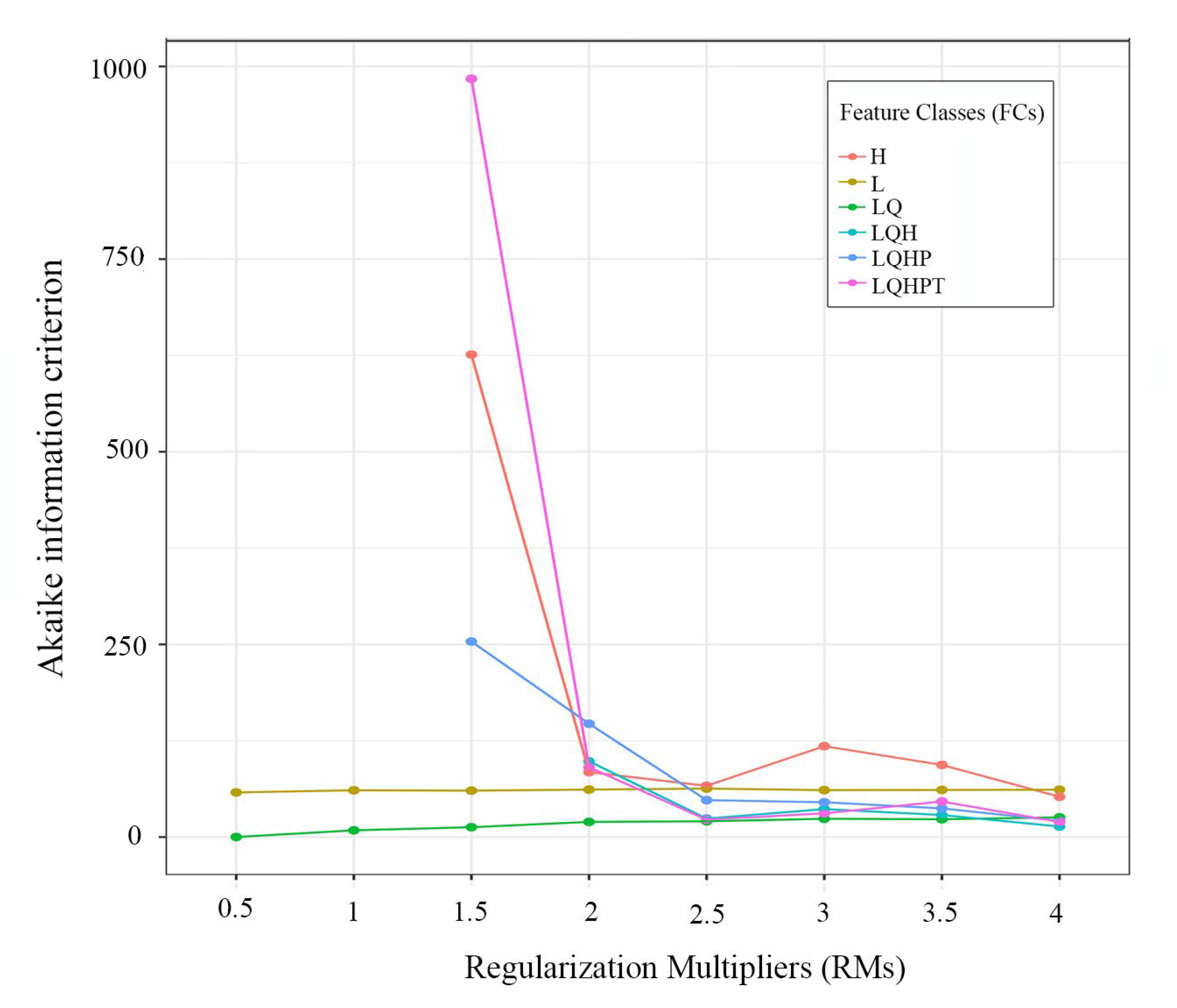
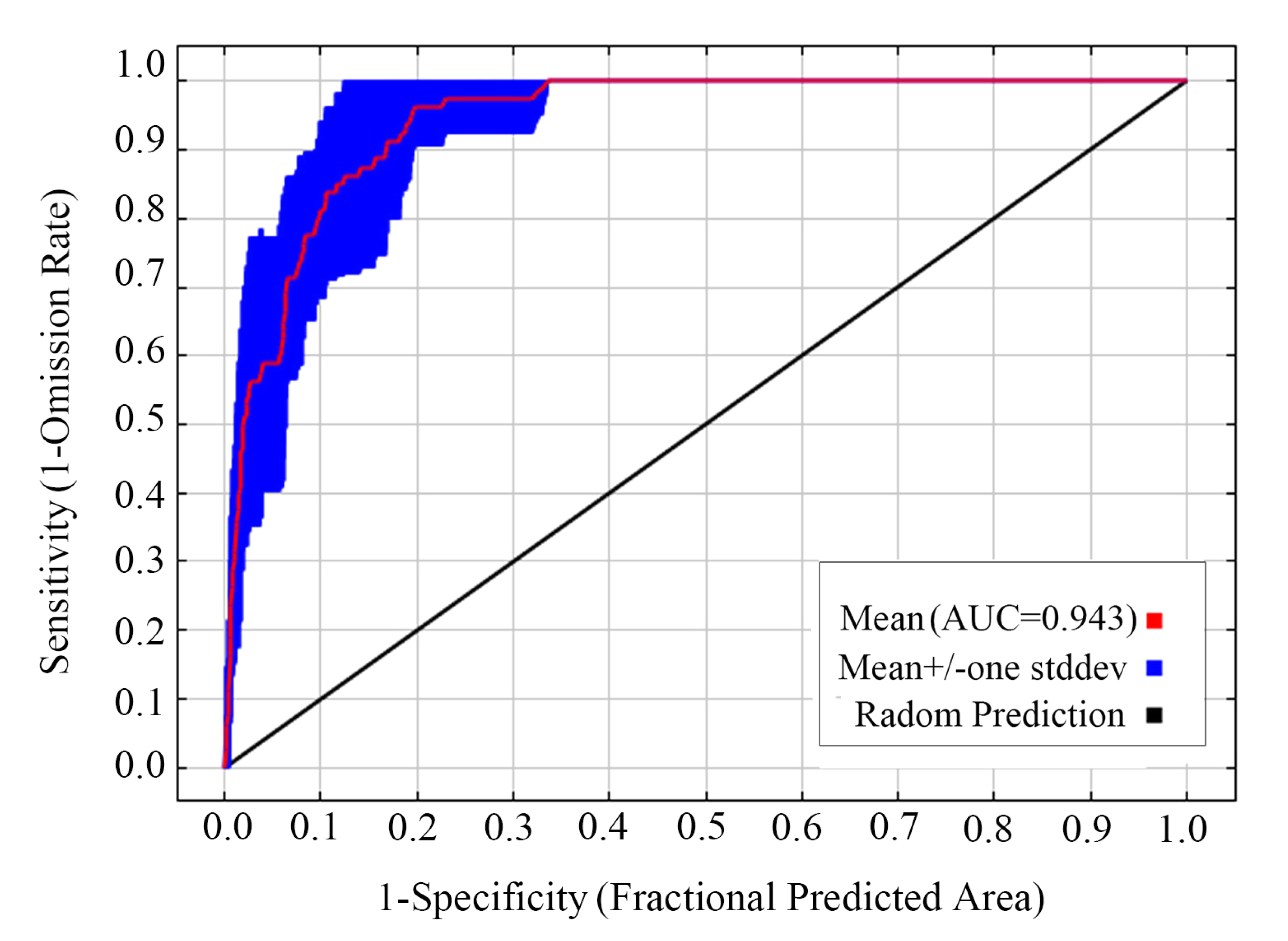
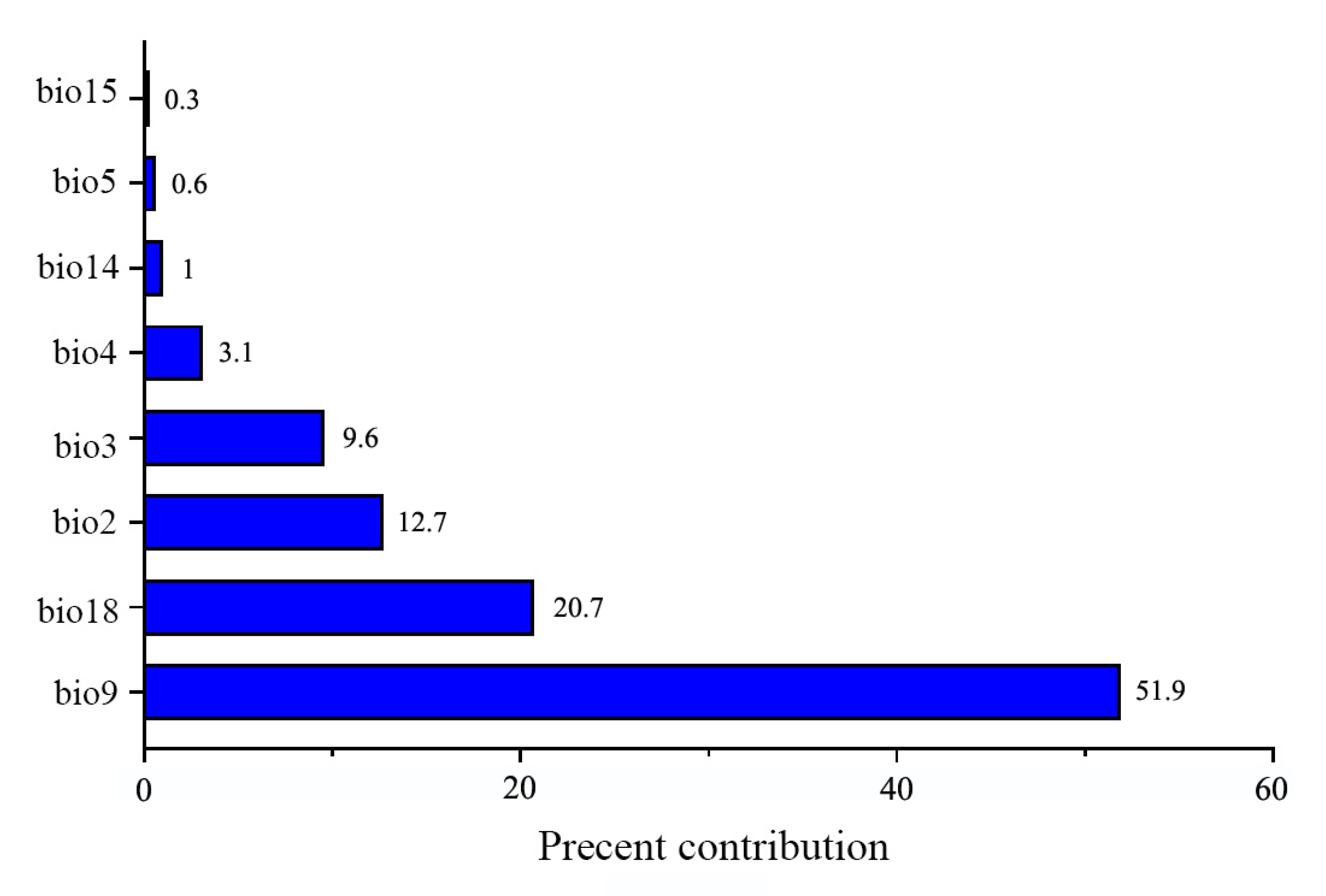
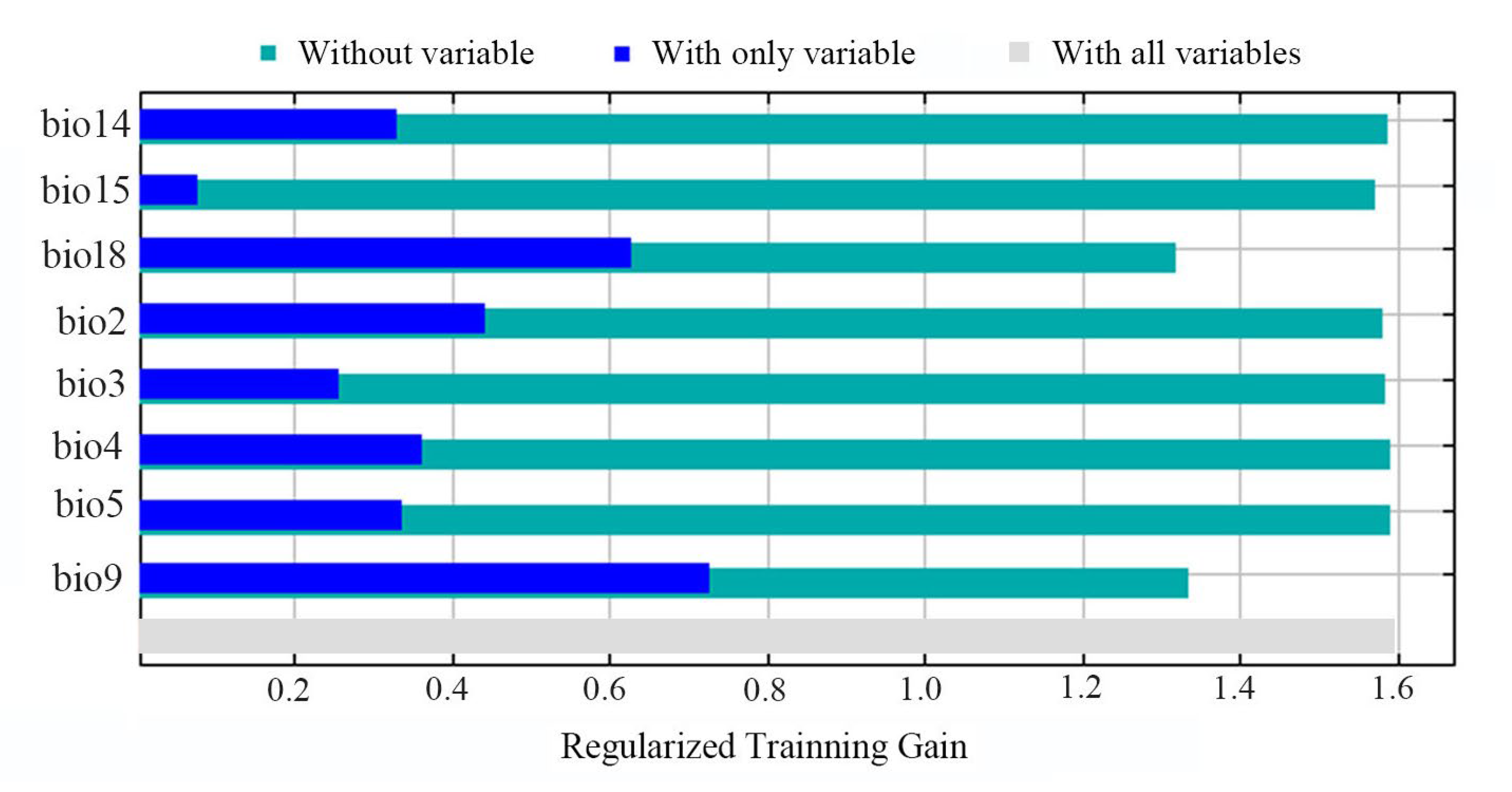
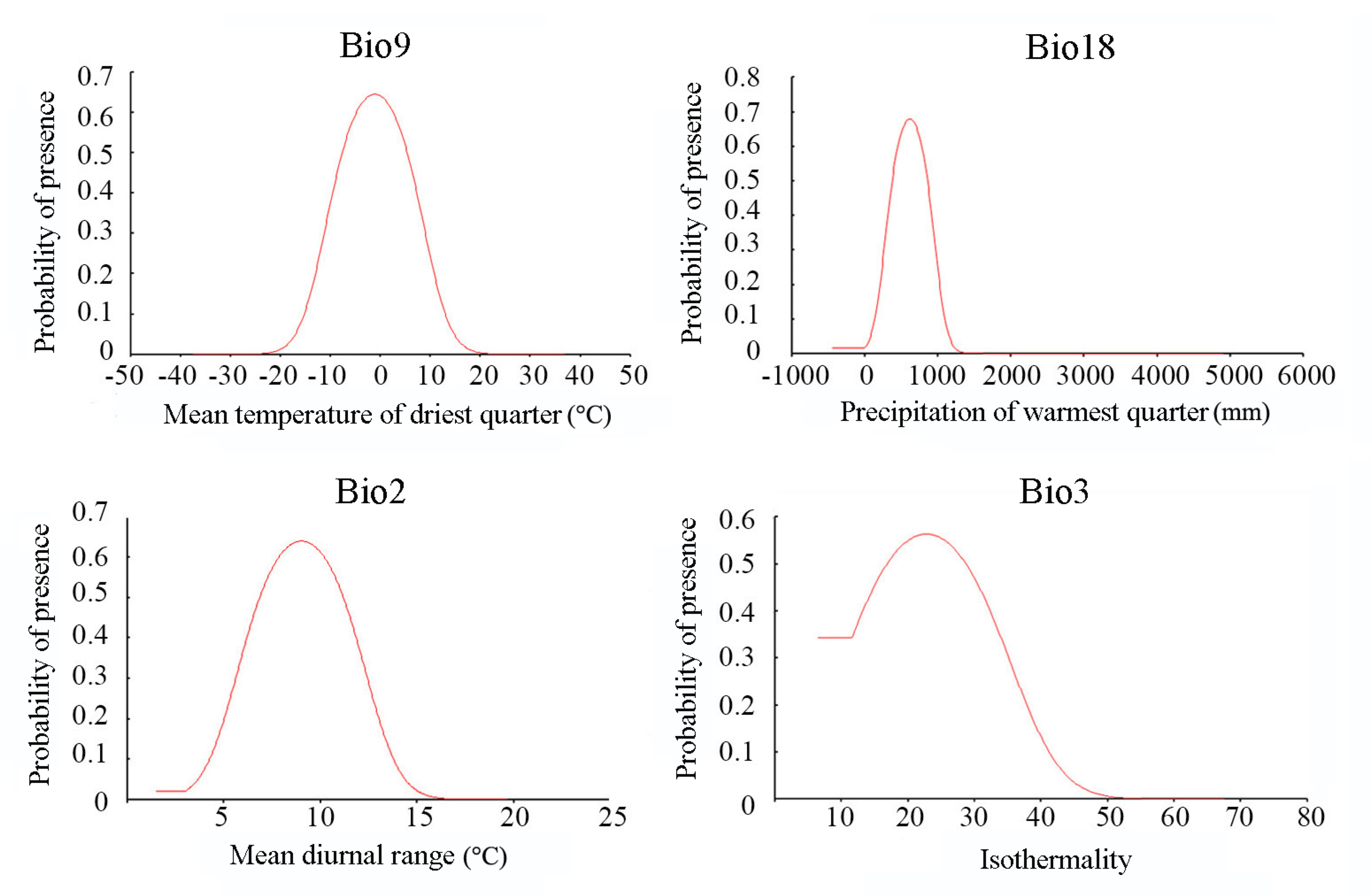

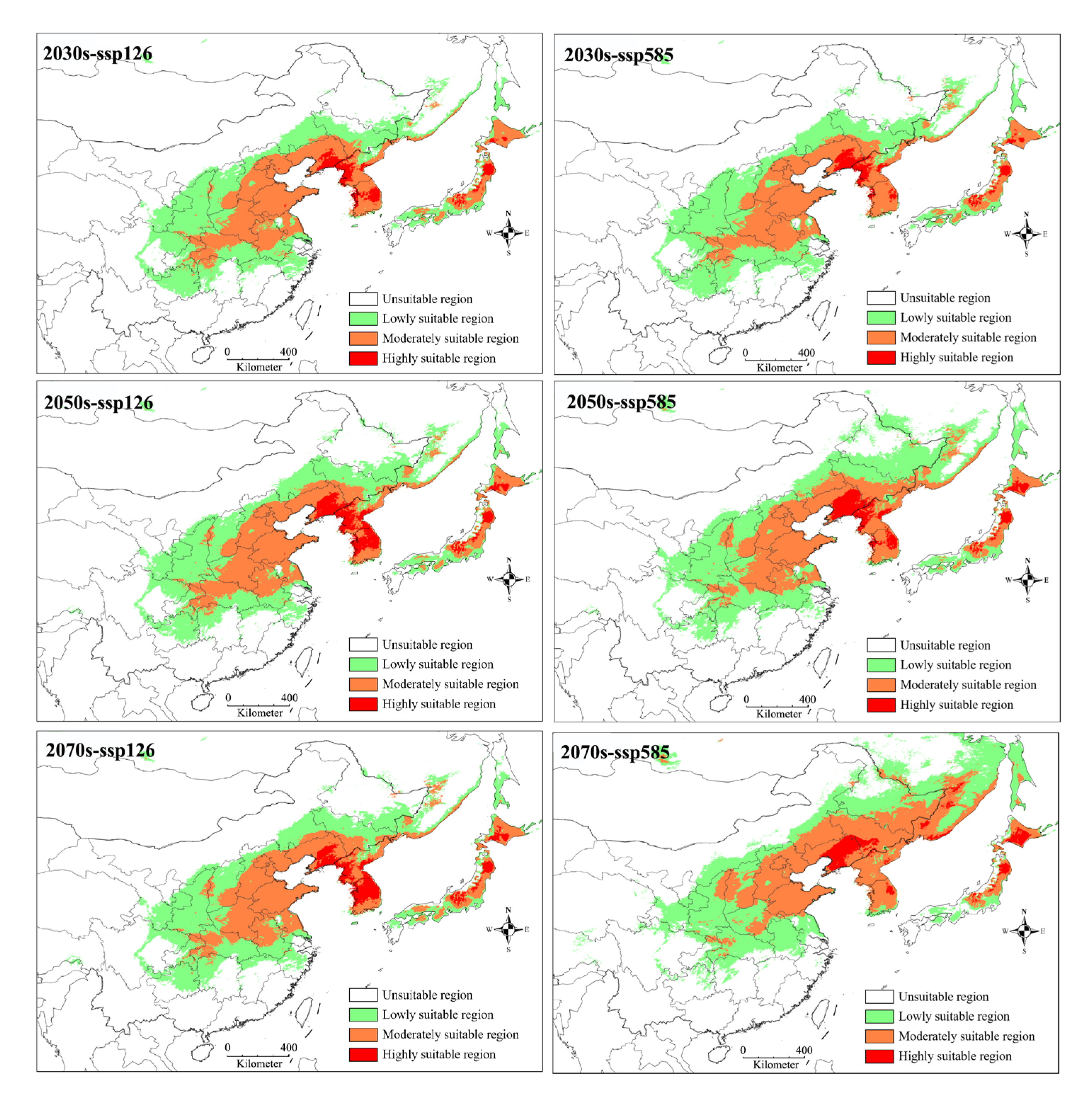
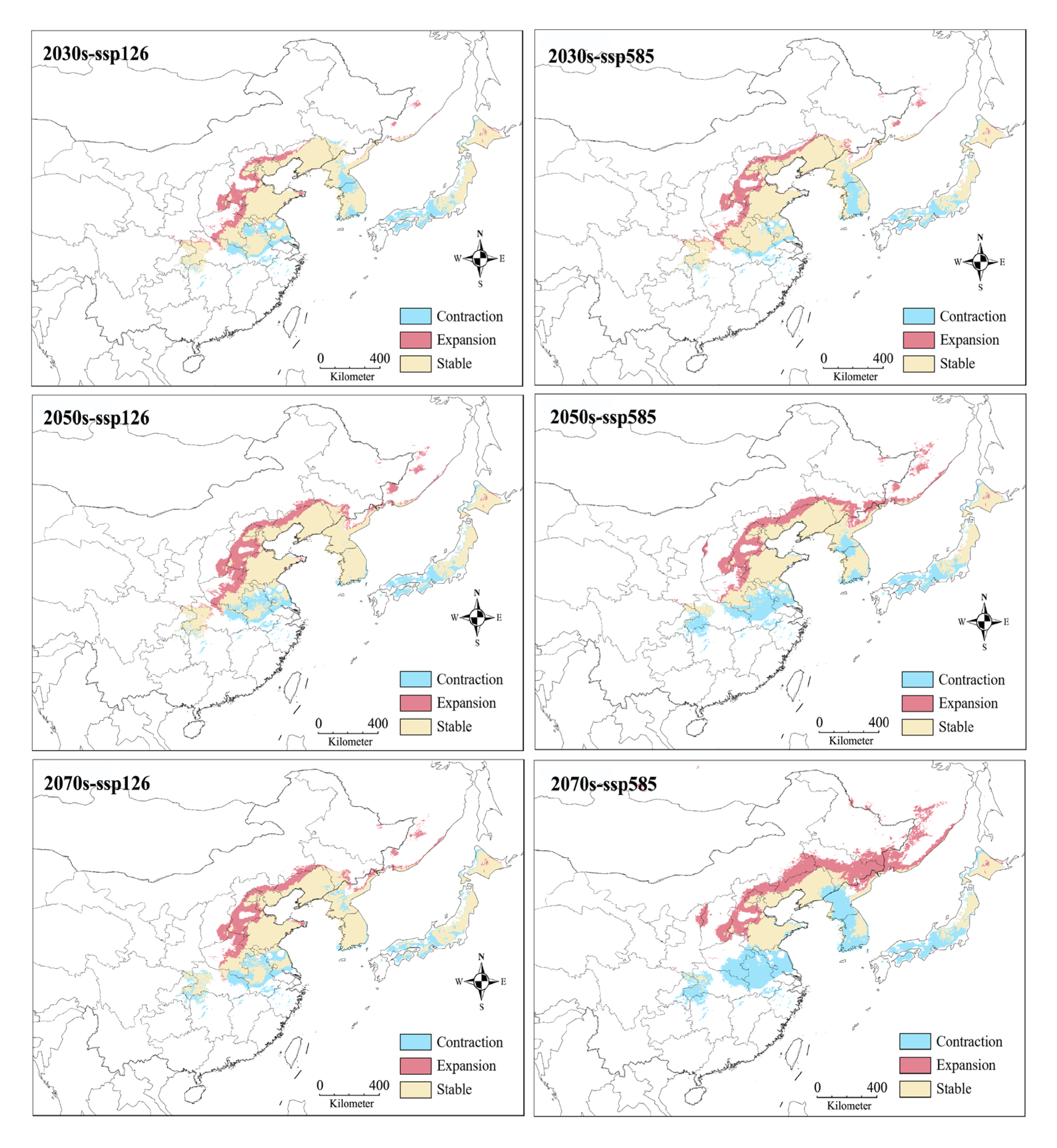
| Decades/Climate Scenarios | Area (×104 km2) | ||||
|---|---|---|---|---|---|
| All Suitable Habitats | Lowly Suitable Habitats | Moderately Suitable Habitats | Highly Suitable Habitats | ||
| 1970–2000 | 273.5 | 172.79 | 80.89 | 19.82 | |
| ssp126 | 2030s | 322.03 | 183.73 | 124.88 | 13.42 |
| ssp126 | 2050s | 341.59 | 194.51 | 125.94 | 21.3 |
| ssp126 | 2070s | 350.1 | 202.37 | 127.82 | 19.91 |
| ssp585 | 2030s | 332.66 | 194.9 | 124.97 | 12.79 |
| ssp585 | 2050s | 376.9 | 224.63 | 132.8 | 19.48 |
| ssp585 | 2070s | 443.35 | 259.63 | 165.45 | 18.27 |
Disclaimer/Publisher’s Note: The statements, opinions and data contained in all publications are solely those of the individual author(s) and contributor(s) and not of MDPI and/or the editor(s). MDPI and/or the editor(s) disclaim responsibility for any injury to people or property resulting from any ideas, methods, instructions or products referred to in the content. |
© 2025 by the authors. Licensee MDPI, Basel, Switzerland. This article is an open access article distributed under the terms and conditions of the Creative Commons Attribution (CC BY) license (https://creativecommons.org/licenses/by/4.0/).
Share and Cite
Huang, L.; Zuo, S.; Huo, Y.; Hu, L.; Wang, Z.; Zhang, J.; Liu, J.; Ding, W.; Ma, K.; Yang, M. Predicting the Current and Future Habitat Distribution for an Important Fruit Pest, Grapholita dimorpha Komai (Lepidoptera: Tortricidae), Using an Optimized MaxEnt Model. Insects 2025, 16, 623. https://doi.org/10.3390/insects16060623
Huang L, Zuo S, Huo Y, Hu L, Wang Z, Zhang J, Liu J, Ding W, Ma K, Yang M. Predicting the Current and Future Habitat Distribution for an Important Fruit Pest, Grapholita dimorpha Komai (Lepidoptera: Tortricidae), Using an Optimized MaxEnt Model. Insects. 2025; 16(6):623. https://doi.org/10.3390/insects16060623
Chicago/Turabian StyleHuang, Li, Shichao Zuo, Yiqi Huo, Lizong Hu, Zhengbing Wang, Jiahui Zhang, Jin Liu, Weili Ding, Keshi Ma, and Mingsheng Yang. 2025. "Predicting the Current and Future Habitat Distribution for an Important Fruit Pest, Grapholita dimorpha Komai (Lepidoptera: Tortricidae), Using an Optimized MaxEnt Model" Insects 16, no. 6: 623. https://doi.org/10.3390/insects16060623
APA StyleHuang, L., Zuo, S., Huo, Y., Hu, L., Wang, Z., Zhang, J., Liu, J., Ding, W., Ma, K., & Yang, M. (2025). Predicting the Current and Future Habitat Distribution for an Important Fruit Pest, Grapholita dimorpha Komai (Lepidoptera: Tortricidae), Using an Optimized MaxEnt Model. Insects, 16(6), 623. https://doi.org/10.3390/insects16060623






